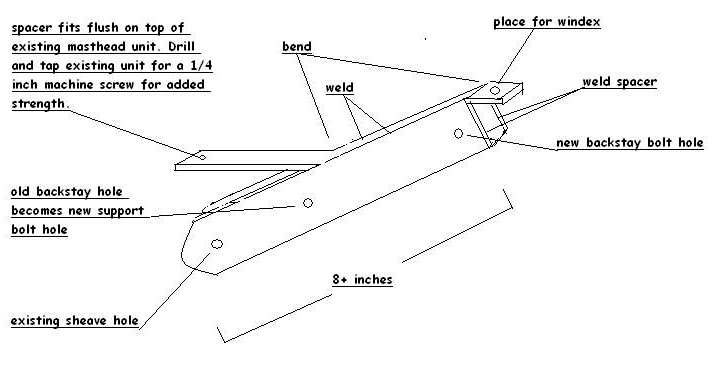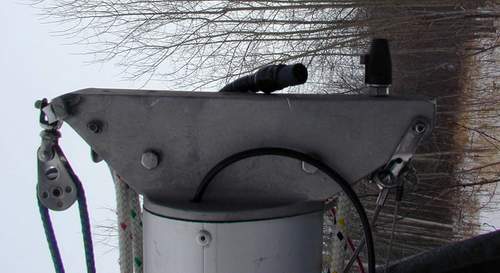| SJ23 Tech Tip F30, (Issued 2005-03-08) Ian Campbell & Bob Schimmel | |
|
Back Stay Crane - How to Retain an Oversize Mainsail Roach. |
|
In 2001 Ian bought a new mainsail from the North Sails loft in Vancouver. My existing mainsail was old and since the mast cross section on an SJ23 is so big I figured there was almost no attached flow for the top 25% of the main. Therefore, I wanted a mainsail with as much roach as could fit inside the backstay. I also wanted the two top battens to be full length to get the best shape up there. My hope was that the top batten would just flick the backstay as the mainsail comes about. Unfortunately this was not the case with my new mainsail! I took all the required measurements as per the form that North Sails sent me. This involved raising the mast in the yard and trying to figure out the exact measurement from the mast to the backstay at the upper black band, the point of maximum hoist. This was achieved by taping a wood ruler to the head board, raise the sail, then climb on the roof with binoculars to read the numbers on the ruler. All of the other measurements, outhaul, etc, were much easier to achieve.
CONSTRUCTION - The extension was easy to build from several sections of 1/4" thick by 1.5" wide aluminum flat bar. The pieces were welded together for strength by a shop in town. One of the happy accidents of the existing masthead configuration is that the sheave hole and the backstay hole are roughly at 900 to the backstay. This means that a bolt-on extension would not require a longer backstay. If the new termination of the back stay is along the arc of the end of the back stay, then the length of the back stay remains constant. Since the masthead fitting is slightly over 1.5" wide, using 1.5" bar stock for a spacer would make the crane fit too tight over the masthead fitting. Therefore, adjust the width of the spacer accordingly. It will likely takes lots of dry fitting to get it right. A picture is worth a thousand words so I will stop gabbing now.
The crane can be made for a perfect fit after the sail arrives. The backstay bolt in this design spans 1.5". After two years of sailing it has yet to bend, although, I would like to narrow the unsupported span for use with the spinnaker. CONCLUSION - The boat sails like a dream with the large roach mainsail and I think I would be happy cruising with a 135 jib in light to moderate winds. Cheers -------------------------------------------- NOTE
1 - Shown above is Panache's mast head rotated to align with
Ian's crane drawing, so ignore the trees in the background OK! This should help to understand Ian's description so he doesn't have to climb up the roof again. That's the spinnaker block at the left. Bob Schimmel.
|
|
|
Return to Tech Tip Index. . . . . . . . . . . . . . . Have a Question? |
|
 When the sail arrived it looked perfect, unfolded on the lawn. When it was hoisted on the mast I discovered the upper batten
overlapped the backstay by about 1.5". The good nature of the afternoon suddenly vanished. During a phone call to
the North loft Dave Miller said, "We often make things a bit bigger because it is easier to trim than to add." However I
couldn't bring myself to return the sail for modifications so I built a crane extension
for the masthead to move the backstay aft a bit.
When the sail arrived it looked perfect, unfolded on the lawn. When it was hoisted on the mast I discovered the upper batten
overlapped the backstay by about 1.5". The good nature of the afternoon suddenly vanished. During a phone call to
the North loft Dave Miller said, "We often make things a bit bigger because it is easier to trim than to add." However I
couldn't bring myself to return the sail for modifications so I built a crane extension
for the masthead to move the backstay aft a bit.  The long horizontal spacer plate at the top
center of the crane bolts to the top of the masthead. This bolt must not penetrate inside the masthead or it will interfere
with the halyard sheaves. There are two other bolts that hold the
extension in position; one through the aft sheave and the other through
the old backstay hole.
The long horizontal spacer plate at the top
center of the crane bolts to the top of the masthead. This bolt must not penetrate inside the masthead or it will interfere
with the halyard sheaves. There are two other bolts that hold the
extension in position; one through the aft sheave and the other through
the old backstay hole.